 |
An experimental Japanese
mission to clear 'space junk' or rubbish from the Earth's orbit has
ended in failure, officials said Monday, in an embarassment for Tokyo.
Over
100 million pieces of garbage are thought to be whizzing around the
planet, including cast-off equipment from old satellites and bits of
rocket, which experts say could pose risks for future space exploration.
Scientists
at the Japan Aerospace Exploration Agency (JAXA) were trying to test an
electrodynamic 'tether' - created with the help of a fishing net
company - to slow down the orbiting rubbish and bring it into a lower
orbit.
The hope
was that the clutter -- built up after more than five decades of human
space exploration -- would eventually enter the Earth's atmosphere and
burn up harmlessly before it had a chance to crash into the planet.
The
700-metre (2,300-foot) long tether -- made from thin wires of stainless
steel and aluminium -- was due to be extended out from a cargo ship
launched in December carrying supplies for astronauts at the
International Space Station.
Problems
arose quickly, however, and technicians tried for days to remedy the
situation but only had a one-week window to carry out the mission before
the vessel reentered the Earth's atmosphere before dawn on Monday.
'We believe the tether did not get released', leading researcher Koichi Inoue told reporters.
'It is certainly disappointing that we ended the mission without completing one of the main objectives,' he said.

Over 100 million pieces of garbage are
thought to be whizzing around the planet, including cast-off equipment
from old satellites and bits of rocket, which experts say could pose
risks for future space exploration
The
disappointment is the latest failure to hit JAXA and comes just weeks
after the agency had to abort a mission that sought to use a mini-rocket
to send a satellite into orbit.
The
agency also abandoned a pricey ultra-high-tech satellite launched in
February last year to search for X-rays emanating from black holes and
galaxy clusters after losing contact with the spacecraft.
The
rocket bound for the International Space Station carrying the vessel
blasted off from the southern island of Tanegashima at around 10:30 pm
local time (13:30 GMT).
JAXA worked on
the project with Japanese fishnet manufacturer Nitto Seimo to develop
the cord, which has been about 10 years in the making.

The 700 metre long space tether was due to be extended out from a Japanese cargo ship that was launched in December 2016. dailymail

Post a Comment Blogger Facebook Disqus